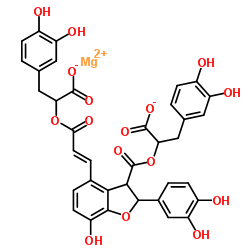Magnesium Lithospermate B
Modify Date: 2024-01-02 16:25:51

Magnesium Lithospermate B structure
|
Common Name | Magnesium Lithospermate B | ||
|---|---|---|---|---|
| CAS Number | 122021-74-3 | Molecular Weight | 740.903 | |
| Density | N/A | Boiling Point | 1020.3ºC at 760mmHg | |
| Molecular Formula | C36H28MgO16 | Melting Point | N/A | |
| MSDS | N/A | Flash Point | 322.1ºC | |
Use of Magnesium Lithospermate BMagnesium Lithospermate B is a derivative of caffeic acid tetramer and extracted from Salviae miltiorrhizae. Magnesium Lithospermate B is widely used for the research of cardiovascular diseases, and it can protect against glucose-induced intracellular oxidative damage. Magnesium Lithospermate B also suppresses neuroinflammation and attenuates neurodegeneration[1][2][3]. |
| Name | magnesium,2-[(E)-3-[3-[1-carboxylato-2-(3,4-dihydroxyphenyl)ethoxy]carbonyl-2-(3,4-dihydroxyphenyl)-7-hydroxy-2,3-dihydro-1-benzofuran-4-yl]prop-2-enoyl]oxy-3-(3,4-dihydroxyphenyl)propanoate |
|---|---|
| Synonym | More Synonyms |
| Description | Magnesium Lithospermate B is a derivative of caffeic acid tetramer and extracted from Salviae miltiorrhizae. Magnesium Lithospermate B is widely used for the research of cardiovascular diseases, and it can protect against glucose-induced intracellular oxidative damage. Magnesium Lithospermate B also suppresses neuroinflammation and attenuates neurodegeneration[1][2][3]. |
|---|---|
| Related Catalog | |
| In Vitro | Magnesium Lithospermate B (20-60 μg/ml; 24 h) decreases LDH activity in the cultured supernatant, increases SOD activity in cardiomyocytes, reduces intracellular ROS and MDA levels, and significantly suppresses cardiomyocytes apoptosis[2]. Magnesium Lithospermate B (1-100 μg/ml) enhances proliferation of neural stem cells (NSCs) in a dose-dependent manner[3]. Magnesium Lithospermate B (10 μg/ml) promotes the differentiation in vitro of NSCs towards neurons[3]. |
| In Vivo | Magnesium Lithospermate B (2-8 mg/kg; p.o. once daily for 16 d) reduces the renal damage of oxidative stress through reduction of reactive oxygen species in old rats[1]. Magnesium Lithospermate B (0.5 μg/g; s.c. for 6 weeks) promotes the neurogenesis and improves the memory in PD models[3]. Animal Model: Young (5-month-old) and old (20-month-old) specific-pathogen-free male Sprague-Dawley rats[1] Dosage: 2, 8 mg/kg Administration: P.o. once daily for 16 days Result: Reduced the protein expression of major subunits of nicotinamide adenine dinucleotide phosphate oxidase (Nox4 and p22phox), phospho-p38, nuclear factor-kappa B p65, cyclooxygenase-2, and inducible nitric oxide synthase. Showed lower levels of senescence-related proteins such as p16, ADP-ribosylation factor 6, p53, and p21. |
| References |
| Boiling Point | 1020.3ºC at 760mmHg |
|---|---|
| Molecular Formula | C36H28MgO16 |
| Molecular Weight | 740.903 |
| Flash Point | 322.1ºC |
| Exact Mass | 740.122803 |
| PSA | 283.70000 |
| LogP | 4.21090 |
| Vapour Pressure | 0mmHg at 25°C |
| Magnesium 2-({(2E)-3-[3-{[1-carboxylato-2-(3,4-dihydroxyphenyl)ethoxy]carbonyl}-2-(3,4-dihydroxyphenyl)-7-hydroxy-2,3-dihydro-1-benzofuran-4-yl]-2-propenoyl}oxy)-3-(3,4-dihydroxyphenyl)propanoate |
| Magnesium lithospermate B |
| Monomethyl lithospermate B |
| Magnesium aspartate hydrochloride trihydrate |
| magnessium lithospermate B |
| Magnesium lithospermate B,Magnesium Tanshinoate B |
| Magnesate(1-),(L-aspartato(2-)-N,O(sup 1),O(sup 4))chloro-,hydrogen,(T-4),trihydrate |
| Magnesium L-aspartate hydrochloride trihydrate |
| 3-Benzofurancarboxylic acid, 4-[(1E)-3-[1-carboxy-2-(3,4-dihydroxyphenyl)ethoxy]-3-oxo-1-propen-1-yl]-2-(3,4-dihydroxyphenyl)-2,3-dihydro-7-hydroxy-, 3-[1-carboxy-2-(3,4-dihydroxyphenyl)ethyl] ester, magnesium salt (1:1) |
| (L-Aspartato(2-)-N,O(sup 1),O(sup 4))chloromagnesate(1-) hydrogen (T-4) trihydrate |
| magnesium hydrogen chloride 2-aminobutanedioate(1:1:1:1) |
| magnesium-L-aspartate hydrochloride |